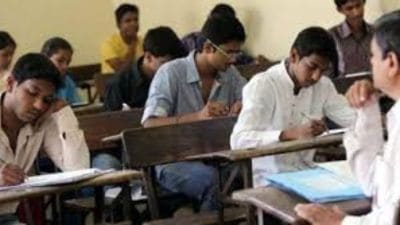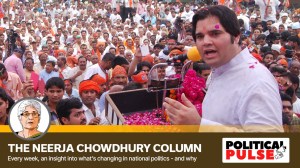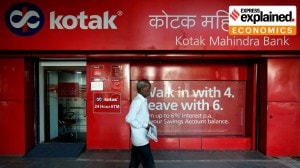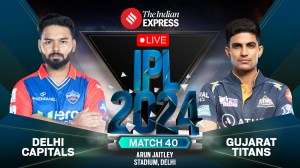- India
- International
UPSC Essentials: Weekly news express with MCQs — EWS to Modi-Putin meet
The Indian Express’ UPSC weekly news express covers some of the important and burning topics of current affairs news from this week to help you prepare for UPSC-CSE. Try out the MCQs and check your answers provided towards the end of the article.
 Essential weekly news categorised as per UPSC syllabus.
(pexels image)
Essential weekly news categorised as per UPSC syllabus.
(pexels image)The Indian Express’ UPSC weekly news express covers some of the most important topics of current affairs news from this week to help you prepare for UPSC-CSE. Try out the MCQs and check your answers provided towards the end of the article. The Post Read Q&A will help you to self-evaluate your retention memory after reading the article.
EWS Quota: Background and Analysis
Syllabus:
Preliminary Examination: Indian Polity and Governance-Constitution, Political System, Panchayati Raj, Public Policy, Rights Issues, etc.
Mains Examination: General Studies II: Welfare schemes for vulnerable sections of the population by the Centre and States and the performance of these schemes; mechanisms, laws, institutions and Bodies constituted for the protection and betterment of these vulnerable sections.
Why in news?
—During the hearing on the challenge to the constitutional validity of reservation for Economically Weaker Sections (EWS) on September 22, Chief Justice of India U U Lalit said: “When it is about other reservations, it is attached to lineage. That backwardness is not something which is not temporary but goes down centuries and generations. But economic backwardness can be temporary.”
Key takeaways
—A quota for the economically backward has long been demanded and debated. In January 2019, the Union Cabinet cleared the 10 per cent quota for EWS.

—The decision of the Union Cabinet to provide reservation of 10% for “economically weaker sections of the people who are not covered by any of the existing schemes of reservation” and to bring in amendments to Articles 15 and 16 of the Constitution for this purpose has to be examined from the point of view of social realities and Constitutional provisions.
Social angle
—It is a fact that there are poor individuals even among the Socially Advanced Castes (SACs), i.e., the non-Scheduled Castes (SCs), non-Scheduled Tribes (STs) and non-Socially and Educationally Backward Castes (SEdBCs). They too do need help. The issue is what is the specific problem they face, and what is the appropriate Constitutionally sustainable solution for it.
Constitutional Provisions
—Principle of Equality, which prohibits the State from discrimination against any citizen on grounds only of religion, race, caste, sex, place of birth or any of them under Article 15(1), and guarantees “equality of opportunity for all citizens in matters relating to employment or appointment to any office under the State” under Article 16(1), in addition to prohibition against discrimination against any citizen on the same grounds as in Article 15(1), specifically with respect to employment or appointment under the State.
—Article 15(4) empowers the State to “make any provision for the advancement of any socially and educationally backward classes of citizens or for the Scheduled Castes and Scheduled Tribes”, and under Article 16(4) provides “for the reservation of appointments or posts in favour of any backward class of citizens, which in the opinion of the State, is not adequately represented in the services under the State”.
—The term “backward class of citizens” has been generally understood, and also defined by the Supreme Court in the Mandal case (Indra Sawhney vs Union of India, 1992) judgment, to include the SCs, STs, and SEdBCs. These are not exceptions, but special provisions to ensure that the principle of Equality enshrined in Articles 14, 15(1) and 16(1) becomes really effective, in the peculiar inherited Indian context of a society riddled by gross inequalities between social classes.
Rationale for SC, ST, SEdBCs reservations
—As the Mandal judgment describes, the founding fathers of the Constitution were keenly and poignantly aware of the “historic injustices and inequities” prevalent over the centuries in Indian society. These were not inequities against individuals. These were deprivations imposed on certain social classes as a whole.
—Such social classes consist of a number of castes. It is well known that the worst affected are the SCs, on whom the caste system imposed “untouchability”, which is not merely a series of humiliating prohibitions and injunctions, but also a mechanism to deprive them of access to education and every opportunity for advancement and upward and outward mobility. Equally deprived, though for different reasons, were the STs, who have been steadily pushed back to remote areas.
—The third category of social classes is that of the SEdBCs, who are not victims of untouchability, but have been accorded a low position and status in society by the caste system, and each of the castes of which have often been traditionally linked with occupations socially considered to be lowly. They too were denied access to education and opportunity to have a “look-in” into administration and governance of the State.
—The Supreme Court in the Mandal case judgment quoted Dr Ambedkar’s statement in the Constituent Assembly while replying to the debate on the provision in Clause (4) of Article 16 (at the draft stage Clause (3) of Article 10) that, “the purpose of the clause (4) was to emphasise that there shall be reservation in favour of certain communities which have not so far had a ‘proper look-in’ into so to say the administration”.
Difference between the Socially Excluded and Deprived and the Poor among the Socially Advanced Castes: Observations of the Supreme Court in Mandal judgment
—Reservation was envisaged only for those belonging to these three social classes. This was part of the national and Constitutional mission to eliminate the gross social inequalities created by the Indian caste system over the centuries, of which the worst victims were the SCs and STs and, though to a lesser extent, the SEdBCs. These inequalities and injustices are not merely a matter of the past, as certain mediapersons say. They continue to be with us at present, though in a quantitatively reduced form, and threaten to continue with us into the future for failure to address this issue comprehensively at its roots.
—The deprivations and backwardness of these three classes is different from the poverty suffered by individuals of the forward castes. These individuals belong to castes which were not interdicted or prohibited or prevented in any manner from access to education and from entry into services under the State.
—The majority judgment in the Mandal case per Justice Jeevan Reddy held that “a backward class cannot be determined only and exclusively with reference to economic criterion. It may be a consideration or basis along with and in addition to social backwardness, but it can never be the sole criterion…”
—Justice Sawant, in his separate concurring judgment, held that economic backwardness of the poor among higher castes is not on account of social backwardness. He also held that the educational backwardness of some of the upper castes on account of poverty can be remedied by economic props alone, which may enable them to gain equal capacity to compete with others.
A quota for the economically poor of the Socially Advanced Castes is not a new idea
—During the debate after his decision to institute reservation for the SEdBCs in 1990, V P Singh, in a conciliatory gesture, offered, if the Opposition agreed, to bring a Constitutional amendment to enable provision of 5% or 10% reservation for individuals who are economically poor, without reference to and irrespective of caste. This conciliatory gesture received scant attention from the Opposition, which was bent upon opposing reservation for SEdBCs.
—Subsequently, the P V Narasimha Rao government, by its O.M. dated 25.9.1991, made an addition to the V P Singh government’s O.M. of 13.8.1990, to provide reservation of “10% of the vacancies in civil posts and services under the Government of India” for “other economically backward sections of the people who are not covered by any of the existing schemes of reservations”. This particular provision was struck down by the Supreme Court in its landmark Mandal case judgment on the ground that the Constitution does not provide for reservation for any individual on economic basis alone or on the basis of poverty alone.
—This is apart from the provision by certain state governments from time to time for reservation for the poor among the non-SC, non-ST, and non-SEdBC castes, which on challenge were struck down by the High Courts or the Supreme Court.
Possible effect of the Constitutional amendment
—Unlike the Narasimha Rao government, the present Cabinet seems to have decided to introduce Constitutional amendments in Articles 16 and 15 to facilitate the provision of 10% reservation for the “economic backward”. The question is whether such an amendment will be constitutionally sustainable.
—One can expect that the present amendment will be challenged in the Supreme Court. The issue of whether the proposed amendment is in keeping with or violative of the basic structure of the Constitution is likely to arise, since the Constitution provides reservation only for any “backward class of citizens” under Article 16(4), and only for measures for SCs and STs and for the advancement of SEdBCs, which includes reservation in education and much else, under Article 15(4), because they suffered, in varying degrees, from exclusion from education and employment under the State and other opportunities of advancement, while individuals of the SACs did not suffer from such exclusion.
—It is likely to be held that the proposed Constitution amendment and the proposed provision of 10% reservation for individuals of the SACs are violative of the basic structure of the Constitution. It is also likely to be held that the grounds for this do not come within the exceptional circumstances in which breach of the 50% limit can be permitted. The appropriateness of the proposed criteria for the SAC poor may also raise question marks. Besides, in the case of reservation in the services, a specific criterion is inadequate representation in the services. The SCs, STs and SEdBCs continue to be inadequately represented, whereas the SACs do not suffer from inadequacy of representation.
Appropriate solutions for the real problem of the genuinely poor among the SACs
—The only problem faced by children and young people of Socially Advanced Castes who are genuinely poor is that they are not able to afford education to the fuller level for want of financial capacity. This problem has to be resolved and can be resolved by having a comprehensive scheme of scholarships and educational loans, so that no child or youth of any caste has to drop out of education at any stage only on account of financial incapacity. At the same time, this should not be at the cost of the SCs, STs and SEdBCs whose needs have till now not been fully provided for, and have to be fully provided for.
(source: ‘Quota for poor: Constitutional and social issues, implications‘ by P S Krishnan, one of the most eminent authorities on the subject explained for The Indian Express the constitutional and social basis for reservations. Krishnan passed away in November 2019. )
Point to ponder: Do you think that the income criterion for determining EWS was “arbitrary”?
1. MCQ:
With respect to EWS, which of the following statement is not true.
a) EWS reservation was granted based on the recommendations of a commission headed by Major General (retd) S R Sinho.
b) Persons who are not covered under the scheme of reservation for SCs, STs and OBCs, and whose family has gross annual income below Rs 8 lakh, are to be identified as EWSs for benefit of reservation.
c) Ministry of Social Justice and Empowerment announced the committee to “revisit the criteria for determining the economically weaker sections”
d) The present income ceiling of Rs 8 lakh fixed for EWS is higher than that for OBCs for quotas for people outside of government.
Death sentence and court’s approach
Syllabus:
Preliminary Examination: Indian Polity and Governance-Constitution, Political System, Panchayati Raj, Public Policy, Rights Issues, etc.
Mains Examination: General Studies II: Structure, organization and functioning of the Executive and the Judiciary—Ministries and Departments of the Government; pressure groups and formal/informal associations and their role in the Polity.
Why in news?
—The Supreme Court on September 19 referred to a larger Bench issues relating to procedural norms for imposing the death sentence. The intervention is seen as a major step in plugging gaps in the way in which trial courts award the death sentence.
Key takeaways
—A three-judge Bench comprising Chief Justice of India (CJI) U U Lalit and Justices Ravindra Bhat and Sudhanshu Dhulia said that there are conflicting judgments on when and how the sentencing hearing must take place, and referred the issue to a five-judge Constitution Bench.
—Section 235 of the Code of Criminal Procedure (CrPC) requires a judge to hear the accused after conviction on the question of sentence, and then pass sentence on him according to law.
—In 1980, the Supreme Court upheld the constitutionality of capital punishment in ‘Bachan Singh v State of Punjab’ on the condition that the punishment will be awarded in the “rarest of the rare” cases. Crucially, the ruling also stressed that a separate sentencing hearing would be held, where a judge would be persuaded on why the death sentence need not be awarded.
—This position was reiterated in several subsequent rulings of the court, including in ‘Mithu v State of Punjab’, a 1982 ruling by a five-judge Bench that struck down mandatory death sentence as it falls foul of the right of an accused to be heard before sentencing.
Conflicting rulings
—At least three smaller Bench rulings have held that while a separate sentencing hearing is inviolable, they can be allowed on the same day as the conviction. Other more recent three-judge decisions have ruled that same-day sentencing in capital offences violate the principles of natural justice.
—A 2020 study by Project 39A, a criminal reforms advocacy group in the National Law University, Delhi, found that in 44 per cent of cases it studied in Delhi, Maharashtra, and Madhya Pradesh, sentencing hearings took place on the same day as the pronouncement of guilt.
—In ‘Dattaraya v State of Maharashtra’, a 2020 ruling, a three-judge Bench of the Supreme Court commuted the death sentence to life imprisonment on the grounds that an adequate sentencing hearing was not held.
An adequate sentencing hearing
—The catena of judgments on sentencing hearings talks about a “meaningful, real and effective hearing” for the accused before awarding the death sentence, wherein the accused can have an “opportunity to adduce material relevant for the question of sentencing.”
—This cannot happen on the same day as that of the conviction. Here, the judge is required to consider not just factors that necessitate awarding the highest sentence, but also the mitigating circumstances.
—In the same suo motu petition, the court is also looking at framing a uniform policy in the form of guidelines for sentencing. The court had indicated in its previous orders “the necessity of working out the modalities of psychological evaluation, the stage of adducing evidence in order to highlight mitigating circumstances, and the need to build institutional capacity in this regard”.
Mitigating circumstances
—In May, in ‘Manoj & others v. State of Madhya Pradesh’, the Supreme Court addressed the lack of a legal framework or institutional capacity to handle death penalty sentencing. The ruling, by a three-judge Bench comprising Justices Lalit (before he took over as CJI) and Bhat, acknowledged the arbitrariness and subjective patterns in awarding the death sentence.
—Studies also show that largely underprivileged, minorities, and scheduled castes and tribes are awarded the death sentence.
—Death penalty sentence is largely driven by the crime in question and not the circumstances of the accused. For example, the Supreme Court’s 1983 ruling in ‘Machhi Singh And Others vs State of Punjab’ introduced “collective conscience” into the capital sentencing framework and laid down five categories, wherein the community would “expect the holders of judicial power to impose death sentence, because collective conscience was sufficiently outraged”.
—The 2020 study by Project 39A found that 72% of all cases in which Delhi trial courts awarded the death penalty from 2000 to 2015 cited “collective conscience of the society” as an influencing factor. The study also found that of the 112 cases in which collective conscience was a factor impacting the decisions of courts, absolutely no other mitigating factor was considered in 63 cases.
—The SC order referring the issue to a larger bench lists social milieu, the age, educational levels, whether the convict had faced trauma earlier in life, family circumstances, psychological evaluation of a convict and post-conviction conduct, as relevant circumstances that should be accounted for at the sentencing hearing.
Point to ponder: The Supreme Court’s initiative to raise the bar on capital punishment is welcome. Discuss.
MCQ:
Which of the following statements is/are true with respect to Project 39A often seen in news?
1. It is a criminal reforms advocacy group in the National Law University of Delhi.
2. It aims to trigger new conversations specifically only on the issue of death penalty.
3. It is inspired by Article 39-A of the Indian Constitution.
a) Only 3
b) 1 and 2
c) 1 and 3
d) All of the above
Live streaming of Supreme Court’s proceedings
Syllabus:
Preliminary Examination: Indian Polity and Governance-Constitution, Political System, Panchayati Raj, Public Policy, Rights Issues, etc.
Mains Examination: General Studies II: Structure, organization and functioning of the Executive and the Judiciary—Ministries and Departments of the Government; pressure groups and formal/informal associations and their role in the Polity.
Why in news?
—From September 27 onward, all proceedings of Supreme Court Constitution Benches will be live-streamed, a full court meeting of the top court has decided. A full court meeting is attended by all judges of the court. The meeting, presided over by Chief Justice of India (CJI) U U Lalit, was held on Tuesday (September 20), at which the decision was taken unanimously.
—Senior Advocate Indira Jaising had written to the judges of the court earlier this month seeking live streaming of proceedings in matters of public and constitutional importance. Back in 2018, the Supreme Court had ruled that live telecast of court proceedings was part of the right to access justice under Article 21 of the Constitution.
—Several of the country’s High Courts already live-stream their proceedings through their YouTube channels. Last month, the Supreme Court live-streamed its proceedings for the first time.
Key takeaways
—In the ‘Swapnil Tripathi’ judgment, in September 2018, the SC had cleared the deck for live streaming of cases of national and constitutional importance.
—The case for live streaming of SC cases of constitutional/national importance is quite strong. Such cases impact various aspects of people’s lives. Therefore, the public’s ability to participate in this conversation by watching these proceedings will not just increase legal literacy but potentially enhance the public’s continuous engagement with the Constitution and laws.
—Such direct engagement is better than a process mediated through some Delhi-based lawyers or court reporters, especially when inexpensive technology allows such live access.
Reasons to be cautious
—With the advent of social media, every citizen became a potential journalist. This was seen as empowering initially because news/views could not be curtailed by the vested interests of editors and news establishments. Yet, with more than a decade’s experience, the increasing realisation is that lack of editorial control has in fact meant informational anarchy, with fake news and propaganda dominating YouTube and social media feeds.
—Indications already exist that snippets of the judicial process, once available in the public domain, are already open to both sensationalism and disinformation.
—Some of the High Courts, such as Gujarat, Karnataka, and Patna, have made their live streamed archived videos available. They are seeing spliced videos of their proceedings splashed over YouTube with titles that scream, “Young lady lawyer’s confidence in court! Will she win?”, “Husband’s secret revealed when wife approached High Court”, “Angry avatar of Justice….”.
—Added to this are videos shared through WhatsApp which take a clip of a few seconds clip from a question/observation by a judge or lawyer and make propaganda videos, often demonising the professional. Most such videos are anonymous and avoid any accountability.
—Judiciary must have credibility in the eyes of the public as an institution, but decisions in individual cases are not expected to be popular. This makes sense as the Constitution requires the judiciary to undo laws and decisions that are unconstitutional, even though made by a popular government. The judges of constitutional courts are sworn to constitutional morality and not popular morality. They are required to “uphold the Constitution” as per their oath.
Introduced without safeguards, live streaming has the potential to have two sub-conscious effects on judges.
—First, during hearings judges may not ask questions or make comments that could be perceived as unpopular.
—Second, there is an increasing trend of oral observations of the court, which are not binding on parties replacing reasoned judgment and orders that are consequential. Live streaming may accentuate this trend, with the reportage being focused on the oral process, rather than the final verdict.
—Similarly, lawyers, aware of their new audience, may choose to grandstand and play to the gallery, especially in a case they expect to lose. Thus, live streaming has the potential to simultaneously suppress desirable speech and enhance undesirable speech within the courtroom.
—An argument in favour of live streaming is that it will bring discipline and improve how judges and lawyers conduct the proceedings, as they are aware that the public is watching. This is indeed possible, but one only needs to look at Parliament for an example of the exact opposite.
Carefully determining how the live streaming proceeds.
—Careful selection of cases for live streaming, not uploading archived stream on the SC website until it is legally/technologically possible to ensure that such videos cannot be spliced and other similar measures that reflect an understanding of how the public consumes (dis)information will ensure that live streaming enriches constitutionalism across the country.
—A hasty and wholesale introduction on the other hand is likely to land the SC right in the middle of the majoritarian and toxic information swamp that prevails in the country.
(source: Shadan Farasat’s article for The Indian Express)
Point to ponder: Adequate precautions are needed for live streaming of court’s proceedings, still it is critical to experiment and innovate. Comment.
MCQ:
Which if the following pair is not correctly matched
1. ‘Swapnil Tripathi’ judgment- SC had cleared the deck for live streaming of cases of national and constitutional importance.
2. ‘Bachan Singh v State of Punjab’- Supreme Court upheld the constitutionality of capital punishment on the condition that the punishment will be awarded in the “rarest of the rare” cases.
a) Only 1
b) Only 2
c) Both 1 and 2
d) Neither 1 nor 2
Syllabus:
Preliminary Examination: Current events of national and international importance.
Mains Examination: General Studies II: Bilateral, regional and global groupings and agreements involving India and/or affecting India’s interests.
Why in news?
—On September 16, Indian Prime Minister Narendra Modi met Russian President Vladimir Putin on the margins of the Shanghai Cooperation Organisation summit in Samarkand in Uzbekistan.
—At the beginning of the meeting, Modi had told Putin: “I know that today’s era is not of war and we have spoken to you many times on the phone that democracy, diplomacy and dialogue are such things that touch the world. Today, we will get a chance to discuss how we can move forward on the path of peace in the coming days. I will also get an opportunity to understand your viewpoint.”
—Putin responded to Modi: “I know your position on the conflict in Ukraine, your concerns that you constantly express.”
Key takeaways
—PM Modi’s comment has caught the world’s attention, seven months into the war. The Indian PM — who has steadfastly stayed away from criticising Putin — has articulated what is music to the ears of Western powers.
—Days later, French President Emmanuel Macron and US NSA Jake Sullivan lent their voice in support of Modi’s comments and asked the Russian President to end the war on Ukraine immediately.
—Macron also said those countries which have chosen to be “neutral” and “non-aligned” are “mistaken” and have a historical responsibility to speak out.
—Macron, delivering his speech at the United Nations General Assembly in New York on Tuesday, said: “Narendra Modi, the Prime Minister of India, was right when he said the time is not for war. It is not for revenge against the West, or for opposing the West against the East. It is a collective time for our sovereign equal states to cope together with challenges we face.”
—In Washington DC, Sullivan said: “I think what Prime Minister Modi said — a statement of principle on behalf of what he believes is right and just — was very much welcomed by the United States.”
—All countries should follow the principle that one cannot conquer its neighbour’s territory by force, Sullivan said.
—While Modi’s comments grabbed the headlines, what is quite significant is Putin’s comments in Samarkand, at the meeting with Chinese President Xi Jinping, where the Russian President acknowledged that Xi Jinping has “questions and concerns” about his war in Ukraine.
—Many analysts have viewed this as a critical turn: This, for the first time, signalled that Beijing is seeking to distance itself from the Russian actions.
—The Russia-China axis has been a worry for the West, particularly for India.
India’s concern
—At a time when India is dependent on Russia for 60 to 70% of its defence requirements, Russian arms supplies might be under stress, worry Indian officials. This has been flagged earlier by Western officials, which has been downplayed by New Delhi.
—But, as the Russian army is seemingly struggling to get more men, the worry is getting bigger for Delhi. It is not yet clear how many of these reservists are fit to fight or have enough weapons.
—From India’s perspective, the message to Moscow is loud and clear: end the war, and get back to business-as-usual.
—Indian Army chief Gen Manoj Pande has underlined this week that they still have “two friction points” along the LAC in eastern Ladakh, obliquely referring to stalemate at Depsang plains and at Charding La nullah in Demchok.
—For the first time, as Delhi braces for the third winter with about 60,000 troops mobilised along the India-China border, and defence supplies from Moscow looking weak and stretched, some in Delhi feel that it is in India’s interest as well that the war in Ukraine must end quickly.
—From Delhi’s perspective, PM Modi has not said anything new. But, framing it publicly and clearly is a powerful message that Delhi needs Moscow to ensure a resilient and reliable supply chain for its defence needs. So, from Indira Gandhi to Narendra Modi, the message to their Russian counterparts about abandoning war has been somewhat consistent, as it has been in India’s interest in strategic cooperation with Russia — from space to defence.
Point to ponder: All major powers are beginning to take a fresh look at the potential outcomes of the Russia-Ukraine war and recalibrate their geopolitical calculus. India will not be an exception. Do you agree?
MCQ:
Which common organisations and connectivity projects have both India and Russia as its members?
1. Shanghai Cooperation Organisation
2. Nuclear Suppliers Group
3. QUAD
4. United Nations Security Council
a) 1, 3 and 4
b) 1 and 4
c) 2, 3 and 4
d) 1, 2 and 3
Post Read Q&A
Can you recall what you read?
- Why is ‘Manoj & others v. State of Madhya Pradesh’ relevant?
- What is the difference between the Socially Excluded and Deprived and the Poor among the Socially Advanced Castes?
- What are the arguments in favour of live streaming of SC’s proceedings?
Answers to MCQs: 1 (d), 2 (c), 3 (d), 4 (b)
Apr 24: Latest News
- 01
- 02
- 03
- 04
- 05







































